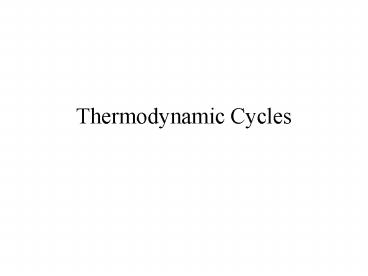Thermodynamic Cycles - PowerPoint PPT Presentation
1 / 15
Title:
Thermodynamic Cycles
Description:
Example: Auto engine: rc~8; g~1.3. hth~0.46 (theoretical); hth~0.30 at ... can show: 1 for b 1. thus: and: when b=1. Ideal Brayton Cycle (Gas Turbines) P. V. 1 ... – PowerPoint PPT presentation
Number of Views:1251
Avg rating:3.0/5.0
Title: Thermodynamic Cycles
1
Thermodynamic Cycles
2
Review Thermodynamic Process
P
3
4
1
2
T
- Thermodynamic processes can be connected together
to form a cycle (connect the dots) - Corners represent the thermodynamic states of the
system - When the processes form a closed figure, its
called a cycle
3
Cycles
- A diagram can be drawn with any pair of
properties - P-T
- P-V (allows the net work of a cycle to be
determined Wintegral of pdV - T-S (gives the net heat of a cycle recall 2nd
law which states ds?dQ/T -gt Qintegral of Tds! - If you can convert some of the heat to work, you
have an engine!
4
Cycle Types
- Premixed Charge Otto Cycle, gasoline,
spark-ignition engine - Non-premixed charge or stratified charge engine
- (compression ignition or Deisel cycles)
- Gas Turbines Brayton Cycle
- Other cycles Rankine,
5
Where to start Air (ideal gas) cycles
- Assume no changes in gas properties (cp, MW, g,
) due to changes in composition, temp., called
the IDEAL air cycle!
- REAL cycles must consider fuel-air mixture
- which is compressed, burned, expanded,
- with accompanying changes in thermodynamic
- properties
6
Premixed Charge Otto Cycle
Expand
4
P
s
v
5
Burn Constant Volume
3
Blowdown
v
s
1
2, 6
V (cylinder volume)
Compress
7
Otto Cycle
8
Thermal efficiency
- hthwhat you get/what you pay for
9
Thermal efficiency
- After some algebra
- independent of heat input
- efficiency increases as rc increases
- why not go to rc -gt ?
- why not?
- geometrical limitations, heat loss,
irreversibilities - (high compression -gt high T -gt high heat
loss), knock
10
Thermal efficiency
- Example Auto engine rc8 g1.3
- hth0.46 (theoretical) hth0.30 at best (expt)
- Differences
- Heat Loss to valves, cylinder walls
- Incomplete combustion
- Friction
- Blow by, valves leak
- Throttling (Pexhaust ?Pintake)
11
Diesel Cycle
Combustion
- Stratified charge engine
- fuel injected after air compressed
- heat release doesnt occur instantly
- since fuel will take more time to
- burn than in the premixed case.
- This is bec. fuel must mix,
- vaporize, than burn. Takes time.
- To model this, combustion process
- assumed to occur at increasing
- volume, constant pressure
3
2
Expansion
P
4
Compression
6
1,5
V
New ratio V3/V2 introduced
12
Diesel Cycle
Define depends on the heat input
can show
gt1 for bgt1
thus
and
when b1
13
Ideal Brayton Cycle (Gas Turbines)
- Isentropic Compression (1-gt2)
- Constant pressure heat addition (2-gt3)
- Isentropic expansion (3-gt4)
- Constant pressure heat rejection (4-gt1)
P
3
2
4
1
V
14
Ideal Brayton Cycle
Heat Added
3
P
Expansion
3
2
T
s
v
2
4
Compression
s
4
v
1
1
Heat Rejected
s
V
15
Ideal Brayton Cycle
Wnet Wt Wc
where PR
Note































